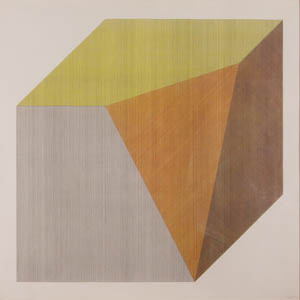As you spend time in the museums’ modern and contemporary wings you are bound to hear the occasional “I-can-do-this” comment directed at a seemingly simple work and wonder “Why is it really here…?” What’s so special about a simple square or a line that makes it important for us to see? The answers, however are never simple.
As Heidi Lee, Director of Waterhouse & Dodd Contemporary and Fine Art Brokers explains, the minimalist works of Sol LeWitt were filled with the artist’s explorations of space, color, dimension, and scale. Sol LeWitt’s works on paper (1983 – 2003) at Waterhouse & Dodd showcase selections from the artist’s 2 last decades of life where he expanded his own visual vocabulary, reaching far beyond the self-imposed boundaries. His omnipresent cubes are complimented by the floating asymmetrical pyramids, sometimes singular, other times joined by others, as if dervishes swirling in a dance. His tools now include gouaches and a richer and a more saturated color palette that made the artist’s hand immediately visible to the viewer. LeWitt’s soul is now more evident in the lyrical compositions of his multi-faceted objects.
Sol LeWitt’s work should be viewed in the historical context of Russian Constructivists, Minimalists and Abstract Expressionists like El Lissitsky, Alexander Rodchenko, Kazimir Malevich, Barnett Newman, Ad Reinhardt, Joseph Albers and others who have chosen the familiar shapes and considered them in brand new contexts thus transforming their very purpose and significance. The exhibition is on view June 22 – August 3, 2012.
Interview Transcript
Heidi Lee: I’m the director of Waterhouse & Dodd and Fine Art Brokers. I’m here today in SoHo, New York and we are in the Waterhouse Gallery featuring Sol LeWitt’s works on paper from the last decades of his life.
We are honored to have this exhibition today by such a significant artist. All the works were acquired directly from the artist himself to the current owners and we are excited to feature just his works on paper, which is part of a significant era of his career, which took place in the last decades of his life.
Sol LeWitt took the formal aspects of art: Line, Perspective, Composition and Form and continuously reworked them. He [created] rules for himself to address all the different variations of making art, that he would unabashedly destroy and create new ones.
In this example of a screen print you can see that it’s a formal cube and it’s in its full complete shape, but when you move to the next cube you see that he cut off the side, intentionally creating an irregular form. He did a whole series of cube works on paper where he would start out with the cube and he would slice off different sides to create these different forms, and you have different planes for the perspective to change. So, here he is altering the perspective, form and he is also using the lines in shading the different directions of the cube, which is also part of the rigid rules he tried to follow.
Of course later on in his life he moved away from the straight line to more squiggly brush strokes, more lyrical compositions and a more vibrant color palette.
The pyramids are an example of him moving into a more intuitive process. Instead of just giving instructions
on creating works of art by drawing four lines in different directions, here is experimenting and he is trying to push his own boundaries and re-write his own rules.
This article and video interview © galleryIntell. Images courtesy Waterhouse & Dodd Gallery. Artwork © Sol LeWitt






















